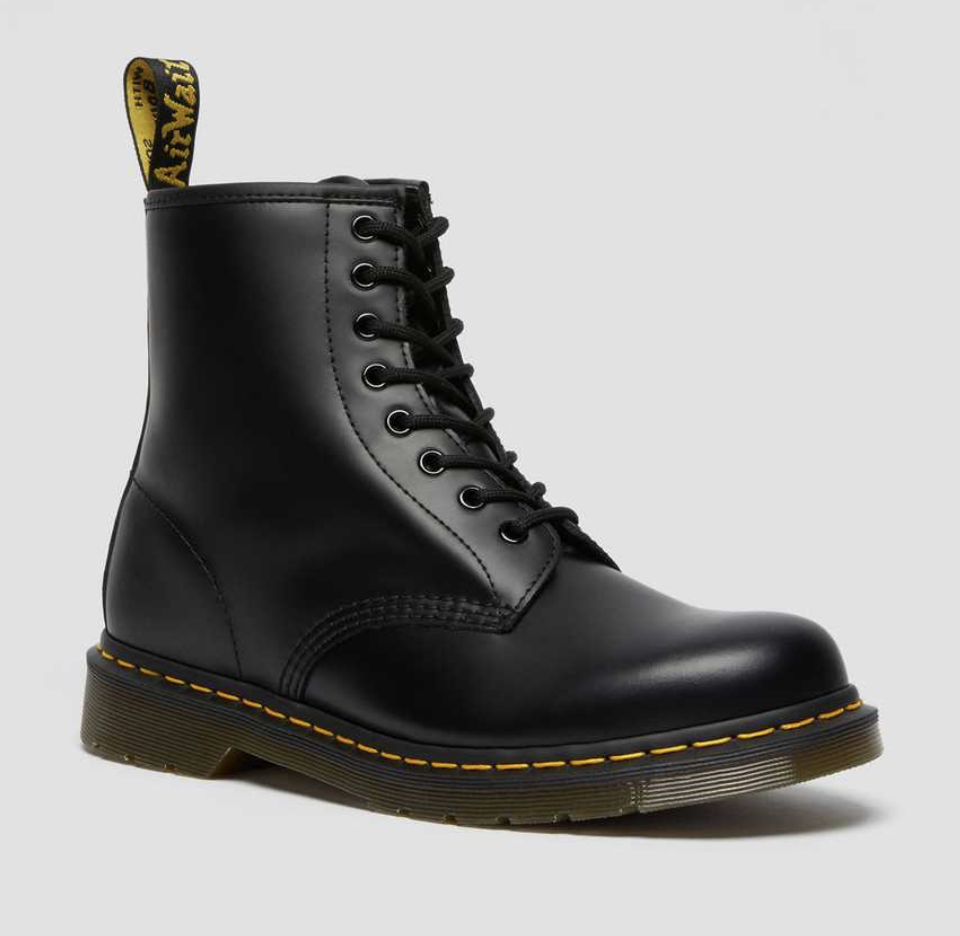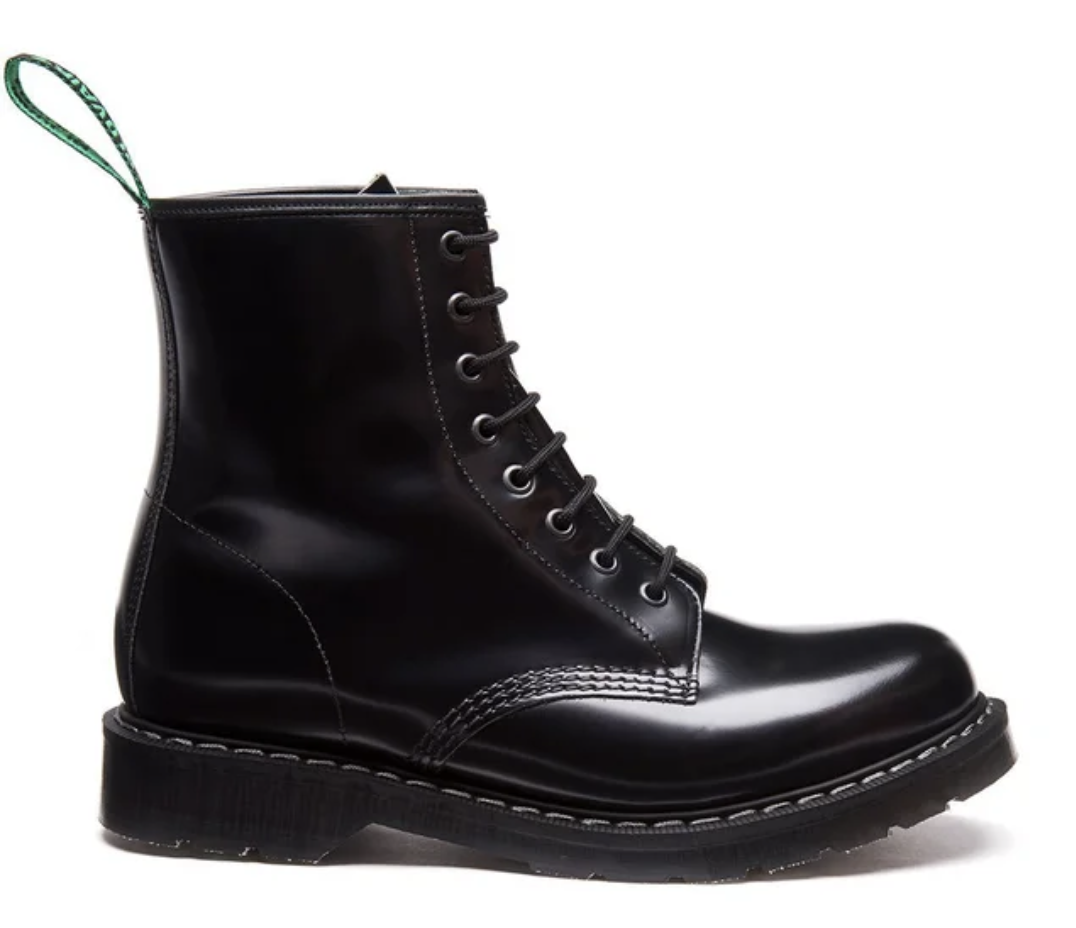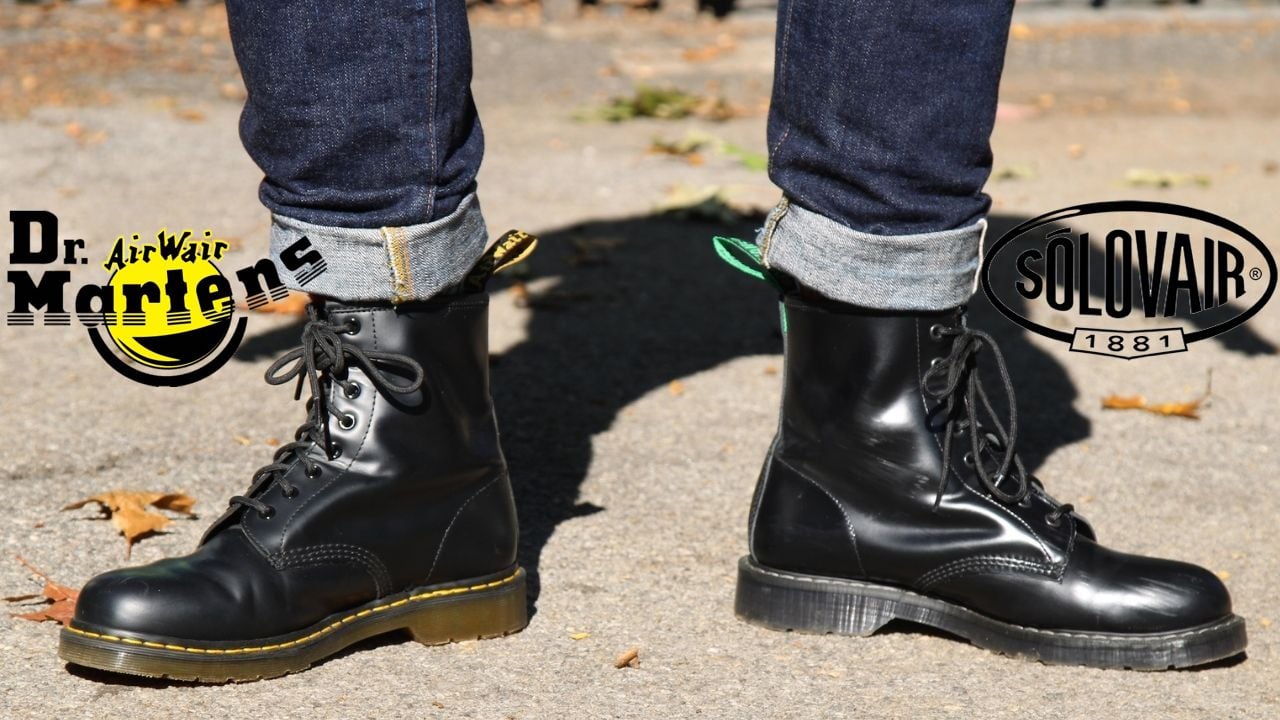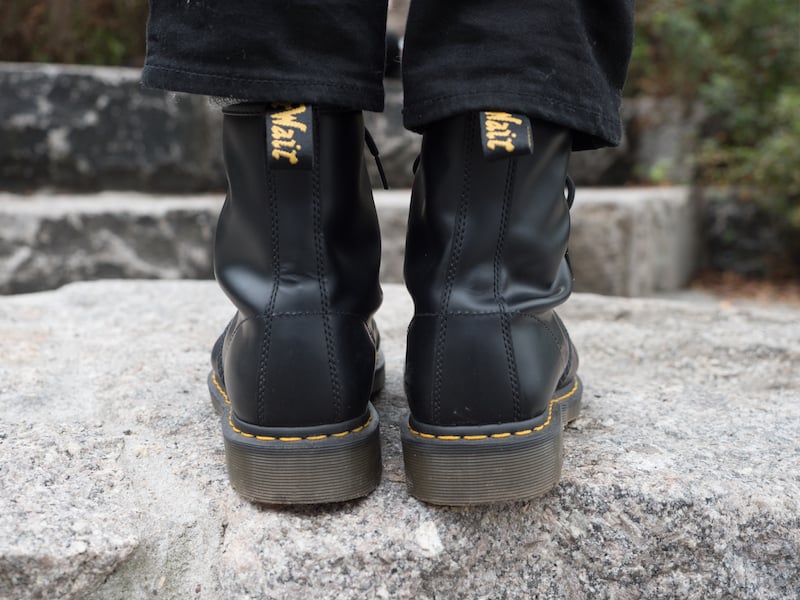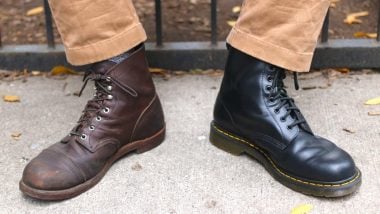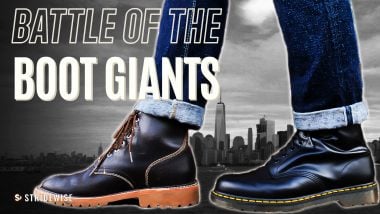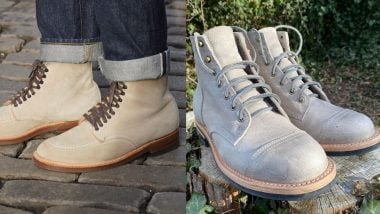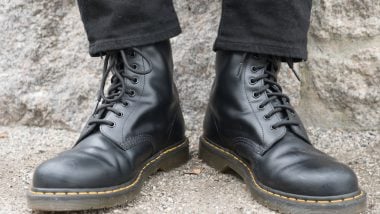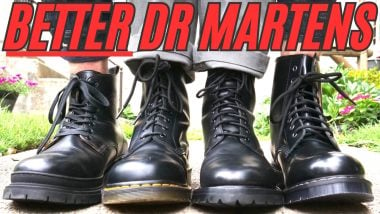Solovair vs. Dr. Martens: The Great British Boot-Off
Ever since I published my first review on Dr. Martens 1460 boots, I’ve been asked to compare them to those of another iconic British boot brand: Solovair. The internet is clamoring with questions about whether these seemingly similar footwear options are comparable — are they the same quality?
How does the construction hold up, brand vs. brand? If you’re on the hunt for quality boots with that cool grungy combat look, these two brands will inevitably surface. Both come out of an England factory, both are made of durable leather, and both even have that iconic pull tab.
So, if you’re trying to choose one pair between Solovair shoes and Dr. Martens boots, what’s the right pick for you? Let’s get into it and explore what makes these two boots— and each company’s shoes — similar and different and why you might prefer one over the other.
For starters, the boots are practically identical, but the two brands also share a very storied history.
Key Takeaways: Solovair vs. Dr. Martens
Both Dr. Martens & Solovair sell chunky-soled, glossy leather combat boots. Solovair’s a higher-quality and Made-in-England, Dr. Martens are more youthful, less expensive, and made overseas.
Similarities:
- 8 eyelets
- Glossy, corrected grain leather
- Bouncy rubber sole
- Vibrant pull tab
- Heat-bonded Goodyear welt construction
The differences:
- Solovair has glossier, thicker, slightly higher-quality leather
- Dr. Martens has yellow stitches
- Solovair is made in England. Docs are made overseas
- Dr. Martens cost $170, and Solovair is about $219
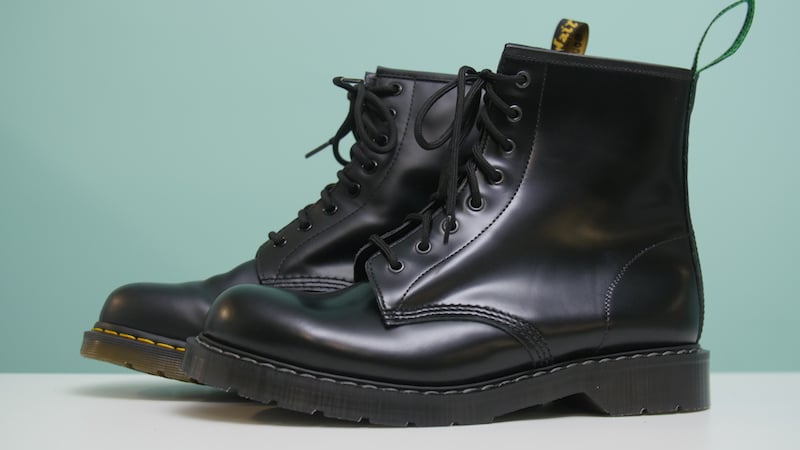
What Is Solovair?
You may be scratching your head as you compare a pair of Solovair boots to Dr. Martens: How can these two pairs of boots look so similar, offer such comparable styles, and both be made in England? It’s no coincidence!
Manufactured by NPS Shoes, Solovair—the name is a portmanteau of the phrase “Sole Of Air,” referring to their lightweight, comfortable foot feel—was actually the maker of Dr. Martens (aka Doc Martens) in Northamptonshire, England, for 35 years. Back then, the boots with the signature air cushion sole were sold under the license “Dr. Martens of Solovair.”
Solovair hasn’t really caught on in the United States the same way Dr. Martens has, but many consider Solovair the real Dr. Martens because when Dr. Martens moved most of its production to Asia, cutting ties with Solovair, Solovair didn’t stop manufacturing boots. Instead, the brand used its facility to make boots that are extremely similar to the Dr. Martens they used to make, but started selling them under the name Solovair.
Make sense? Dr. Martens stopped paying Solovair to make its boots so they could make them overseas, but Solovair just kept on making virtually identical boots with very similar features under a different name.
What’s Better? Solovair Vs. Dr. Martens
So which one is better? Here’s what we’re looking at:
The 1460's combat boot silhouette, combined with a cushy sole and trademark contrast welt stitching, has kept customers coming back for nearly 80 years.
Solovair Black Hi-Shine Derby Boots are made in England and provide wearers with a clean yet modern design. The silhouette is classic and the brand offers this boot in a myriad of leathers.
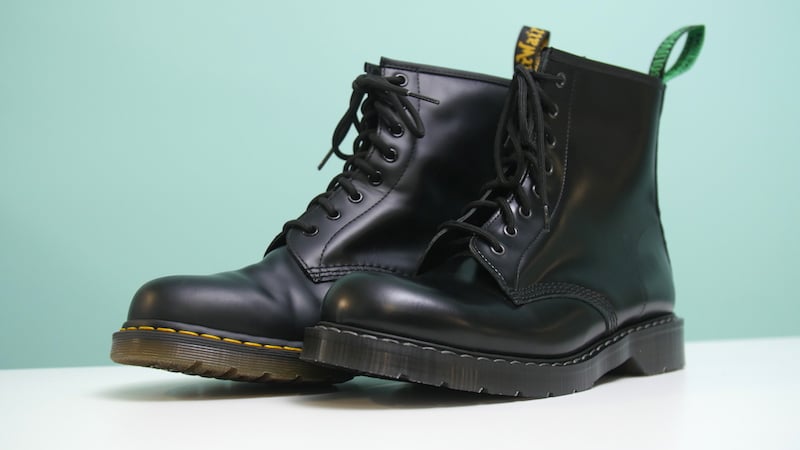
Wait, Why Not Compare Solovair With the “Made in England” Dr. Martens?
Dr. Martens is still designed in Camden Town, London, but while Dr. Martens does sell a British-made Dr. Marten, 99 percent of all the company’s boots are no longer made in England — they’re made in China, Vietnam, Laos, and Thailand. The flagship 1460 boot, the most iconic shoe in the brand’s product line, is actually made in Asia. Dr. Martens even says on its site that this made-in-Asia boot is “The original Dr. Martens boot.”
The 1460 is what the vast majority of people buy, and it’s the company’s principal product, so it makes the most sense to compare it to Solovair’s signature boot.
Solovair vs. Dr. Martens Aesthetics
- 8 eyelets
- Glossy, corrected grain leather
- Bouncy rubber sole
- Vibrant pull tab
The differences:
- Solovair is glossier
- Dr. Martens has yellow stitches
Let’s be honest: Both shoes are pretty similar, and they both have a cool, alternative, self-expressive style. They’re both made with a shiny, corrected-grain leather upper (meaning it’s been smoothed down to eliminate the grainy, skin-like appearance of full-grain leather).
However, the Solovair has a slightly glossier leather. They both have 8 pairs of eyelets, a bouncy rubber sole with slightly lifted heels, triple stitching along the sides, and single stitching at the counter and along the eyelets.
Take a look at just how aesthetically comparable these boots are below.

Where they differ, style-wise — and for now, we’re just talking about their exterior and what you see when you first look at the boots — is that the Solovairs have a slightly stubbier look to the toe, and the stitching is much more muted vs. Dr. Martens’ signature contrast stitching.
Some people don’t love the trademark bright yellow stitching on Dr. Martens, and they may find the more sober stitching style on the Solovairs to be more versatile. Then again, other people think the yellow stitching is almost the whole point of getting a boot like this.
The stitching along the sole actually serves different purposes on each boot, but first, let’s check the leather.
[Related: My List of The Best Boots for Men]
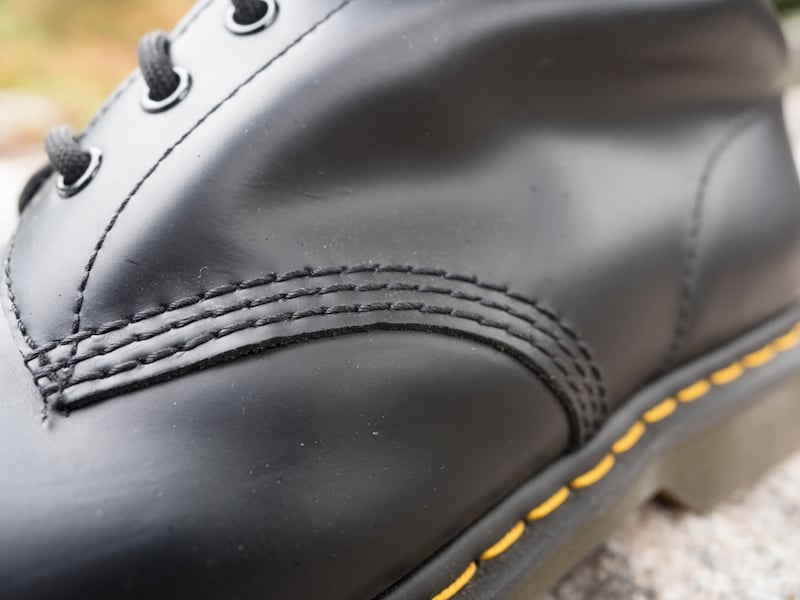
Solovair vs. Dr. Martens Leather
- Dr. Martens from “South America or Asia”
- Solovair European tanneries and cattle
- Both smooth and glossy
- Solovair’s is thicker and more robust
Solovair has matte, greasy “Hi-Shine” leather, whereas the 1460s are more of a medium shine.
Dr. Martens doesn’t say a lot about the origin of its leather. When I called them up to find out, all they said was that it comes from “South America or Asia,” which is a pretty broad net to cast (we’re talking a region of 5 billion people!).
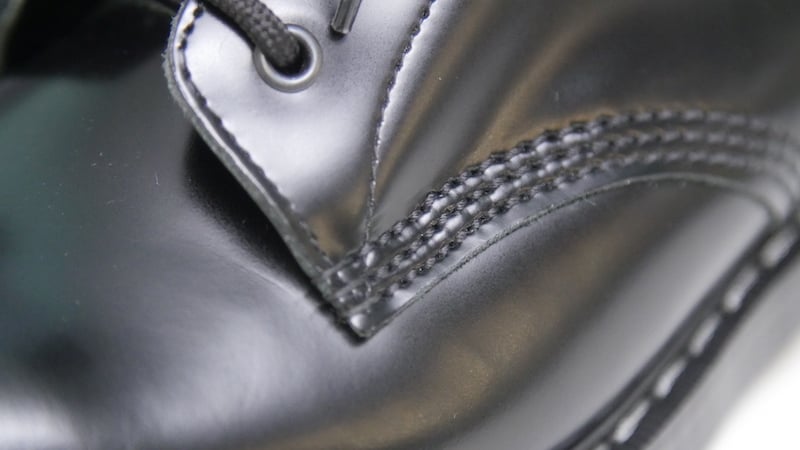
Solovair is a little more precise, guaranteeing that it’s from European tanneries and European cattle, a fact that’ll please the purists for whom made-in-England designation — or at least “made in Europe” — is really important.
As previously mentioned, the leathers used on the boot upper for both brands are corrected grain, meaning it’s remarkably smooth to touch, but the leather on the Solovairs is significantly more robust. The Dr. Martens has a much looser fiber structure and “floppier” feel; there’s more integrity to the Solovair’s leather.
To be clear, neither of these options is an example of amazing boot leather, but Solovair’s is thicker and less plasticky. This also means they come with a tougher break-in, but it’ll be worth it in the long run.
[Related: The Best Types of Leather for Boots]
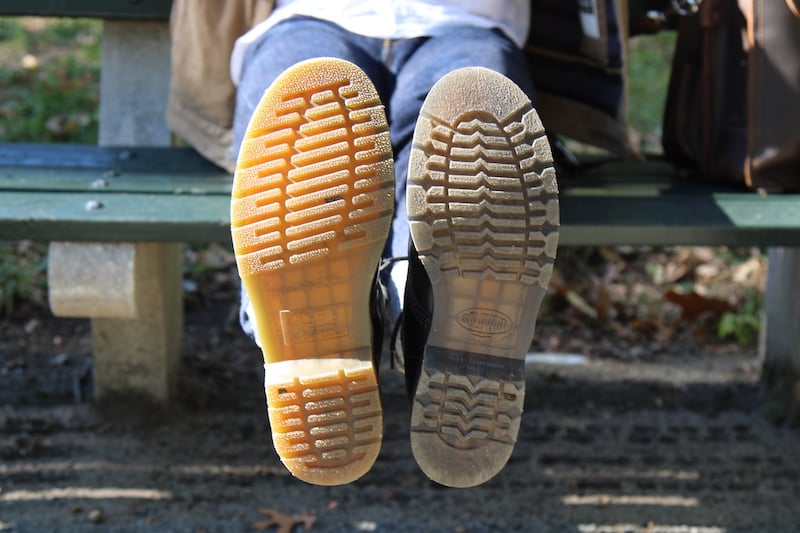
Solovair vs. Dr. Martens Soles
The comfortable sole made Docs famous, and it’s my favorite thing about the boots. In fact, Dr. Klaus Maertens—the founder of Dr. Martens—made the soles of his first boots with discarded rubber from the German Air Force (he was a doctor in the German army in World War 2) and they were originally marketed as a solution to age-related foot pain. That’s why they’re so soft underfoot and cushioned.
Dr. Martens
- Rubber outsole
- Cork midsole
- Polyurethane foam insole
- Hard to resole
- No shank
The shock absorption is fantastic, the rubber is soft but not too soft, and overall, these boots are a delight to walk around in. The footbed is made with a polyurethane foam that compresses over time, though, and that, coupled with the absence of a shank means that the shoes aren’t so great for long-term wear or all-day wear.
Many people report no problems, but factory workers and folks who have to be on their feet for a living tend to note that they don’t prevent foot pain the way that well-made, pricier boots do.
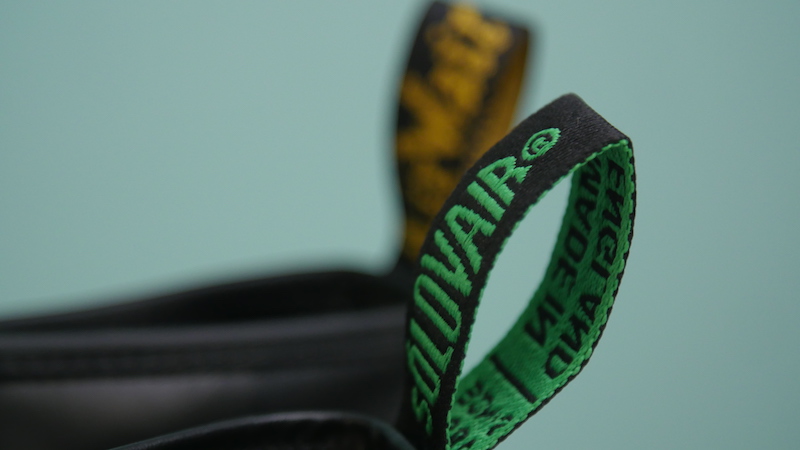
It’s also worth noting that it is tough to find a cobbler to resole Dr. Martens boots. The boots are advertised as having a Goodyear welt, but it’s not really a Goodyear welt.
The upper is heat-sewn to the sole with flame, which is cool and all, but that does make these boots very hard to resole. Some cobblers specialize in resoling Dr. Martens if you’re happy to mail them your boots, but your average cobbler might not be able to.
Further Reading
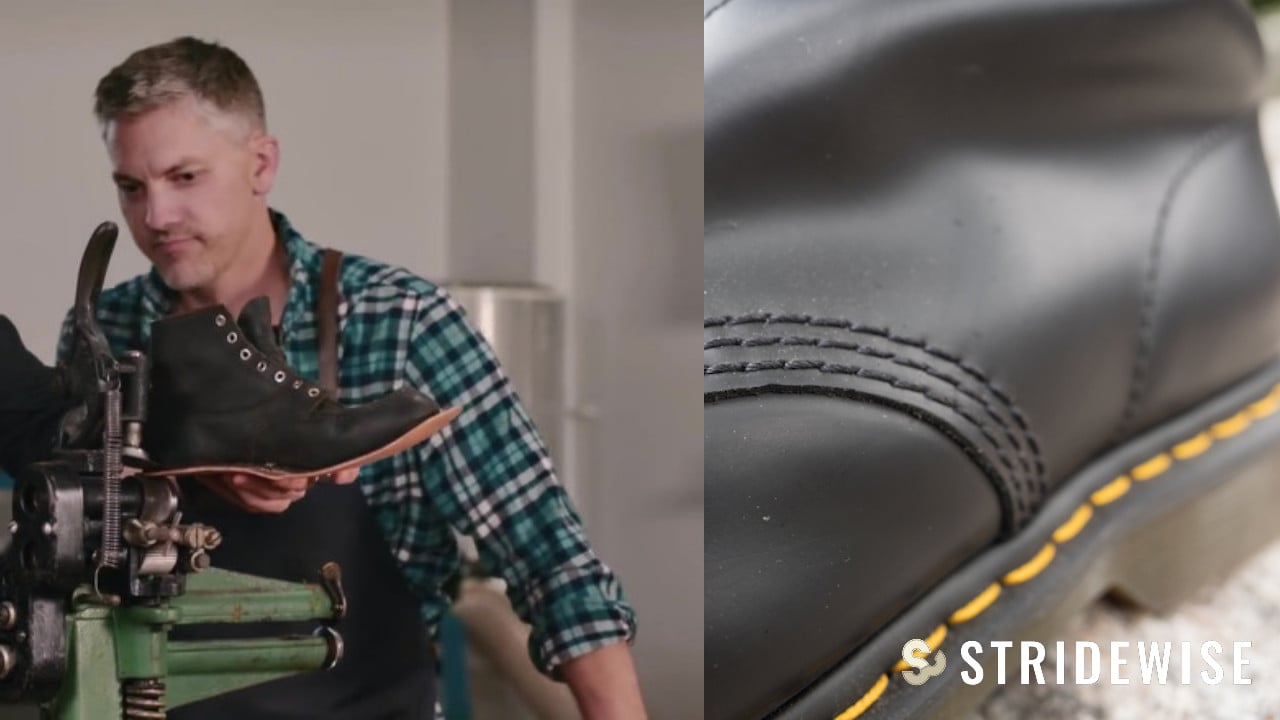
Can You Resole Doc Martens? Yes. But Should You?
I met up with expert cobblers to learn about resoling Doc Martens. Learn more →
In summary, this is a nice soft sole that has great shock absorption but isn’t great if you’re on your feet all day.
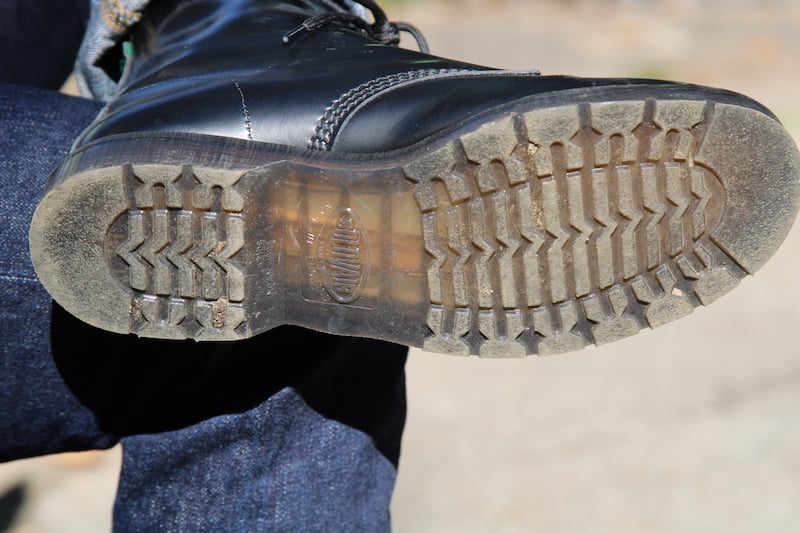
[Related: The 8 Best Boot Soles You Should Know About]
Solovair
- Rubber outsole
- More padding under the heel, less under the toes
- Wood shank
- Resoleable
- A little more rigid than Dr. Martens
This shoe also comes with a rubber outsole that’s a tiny bit less springy, but not to a significant degree.
Regarding the rest of the boot’s construction, there’s more foam under the heel but less padding under the toe relative to the Docs. But the big thing to note is that Solovairs do have a shank. It’s made of wood, not steel, so it’s a bit more liable to break over time if you happen to bend the particularly bendy sole aggressively.
Nonetheless, the consensus is that Solovairs are more comfy than Docs when spending all day on your feet—and the boot’s shape holds up better over time as well.
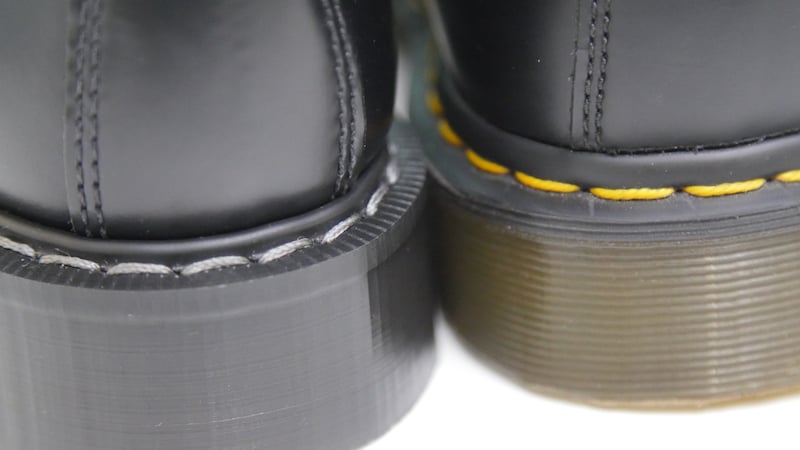
The non-yellow “welt” stitch on the Solovairs, meanwhile, is actually decorative. It’s a second stitch, which is hidden on the inside of the boot, that’s keeping things together. But the take-home message here is that the Solovairs are resoleable.
In summary, Solovair’s sole is a tiny bit more rigid, but the foam under the footbed is better quality, the arch support is much better, the stability is better, and they’re resoleable.
[Related: Dr. Martens vs. Timberland]

Solovair vs. Dr. Martens Sizing
- Dr. Martens: Size down to the nearest whole-size
- Solovair: Use British sizing (usually one whole size down from US sizing)
One of the most surprising things about Dr. Martens is that they don’t offer half sizes. We’re talking about perhaps the most recognizable boot brand on Earth, and they don’t make half sizes. As someone who’s typically an 11.5 shoe size, this is frustrating. The company recommends sizing down half a size to one full size to find your fit. I went down to an 11 and it’s a little big, but a 10 would be too small. So, personally, I’m stuck with a blobby, not-so-great fit on the Docs.
Further Reading
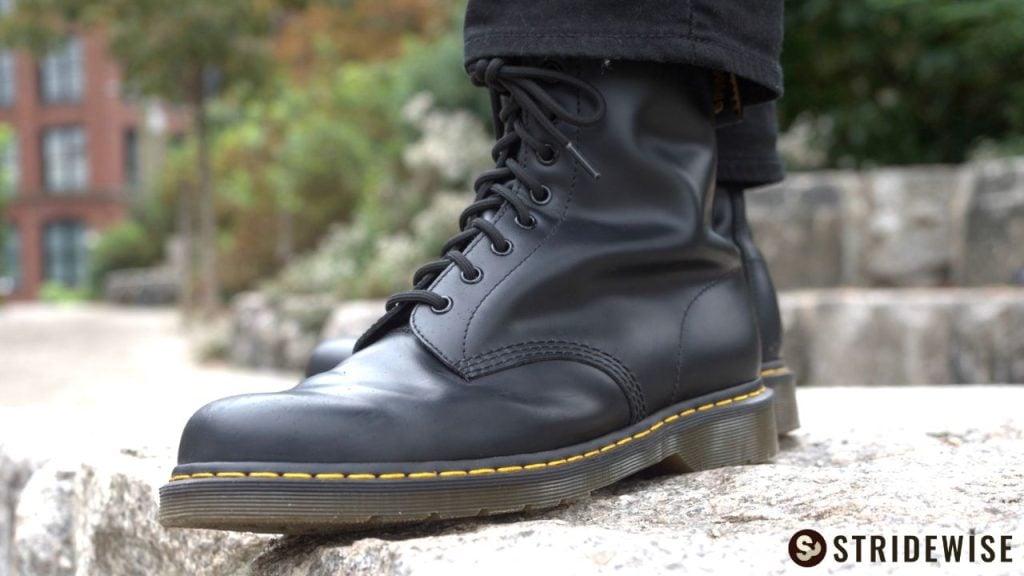
How To Break In Doc Marten Boots
As the cheaper alternative, Docs are currently more popular than Solovair. For that reason, we’ve made a guide for new buyers on how to break in a pair of these iconic boots. Read more
Meanwhile, Solovair does offer half sizes, but they use British sizing. On the brand’s site, it helpfully offers conversion to US sizing; when picking a size, this is what the drop-down options look like:

Further Reading

16 Best Boots For Men to Buy Tested By Experts (Spring 2024)
We’ve spent an inordinate amount of time and effort finding the best boots on the market for guys who want durable casual leather boots that’ll last a lifetime. Learn more →
Usually, your British size is one full size down from your true size in US sizes.
As you can see, a UK 10.5 is a US 11.5, and so on. Easy conversion. If you’re using your US size as a reference with Solovair, it’ll be your true size—the one you’ll get on a Brannock device in a shoe store. That’s typically half a size smaller than your sneaker size and half a size bigger than your lace-up boot size, although sizes can vary a bit brand by brand.
In short, I’m the same size (UK 10.5) in both Dr. Martens and Solovair. Since Dr. Martens doesn’t offer my true half size, I had to go with a slightly too big 11 for Docs, but I can stick to a 10.5 UK/11.5 US for Solovair.

Solovair vs. Dr. Martens Price
- Solovair: A little pricier at $219
- Dr. Martens: A little more affordable at $170
The 1460's combat boot silhouette, combined with a cushy sole and trademark contrast welt stitching, has kept customers coming back for nearly 80 years.
Solovair Black Hi-Shine Derby Boots are made in England and provide wearers with a clean yet modern design. The silhouette is classic and the brand offers this boot in a myriad of leathers.
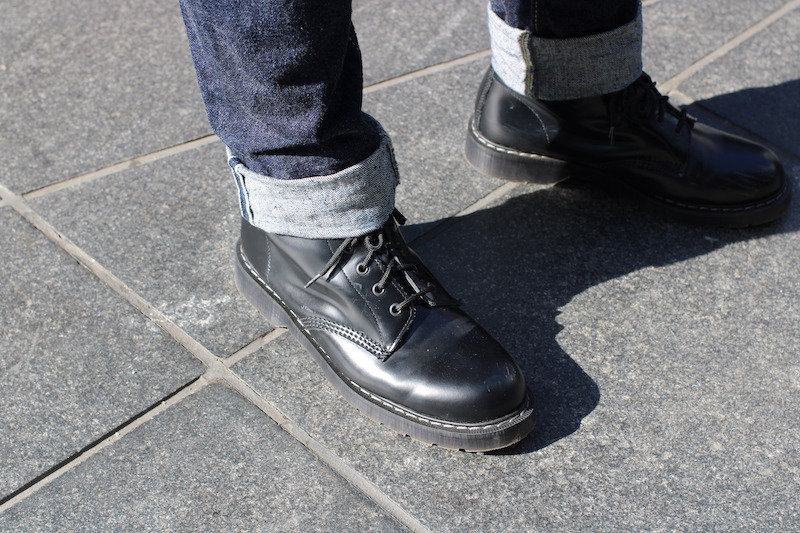
Solovair vs. Dr. Martens Pros & Cons (and Other Considerations)
It would feel disingenuous to exclude cultural cachet as a factor when buying a pair of Dr. Martens. I feel like the best line that summarized what advantages the Docs may have was in a review I saw on Gear Patrol:
As far as cultural cachet is concerned, Dr. Martens has it in spades (…) The yellow welt stitching is almost as iconic as the Levi’s red tab.
But putting that aside, Docs’ soles are softer, the leather’s more comfortable (since it’s thinner and more flexible, and the price point is considerably cheaper.
Here are the main benefits of each boot:
Dr. Martens
- Softer outsole
- Leather’s more comfy (at first)
- Cheaper
Solovair
- Better quality, more durable leather
- Maintain shape better
- Resoleable
- Better arch support
I think it’s fair to say that most people who want Doc Martens buy them because they like the look and the heritage. It’s possible, though, that they’d spend a little more if they could find boots that look like Doc Martens but are higher quality—and Solovair boots certainly fit that bill.
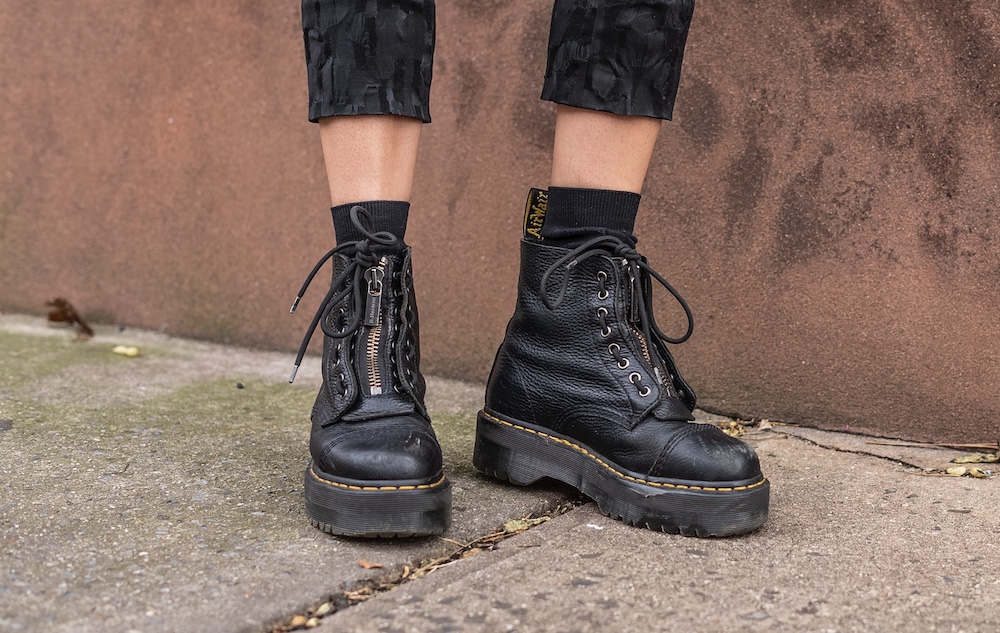
If that’s you — if you’d spend a little more for something made in Europe, with better durability — you should invest in a pair of Solovairs. At first, they might take a little longer to break in, but long term, they’ll be more comfortable, keep their shape better, and can be resoled.
So, which boot should I get?
If you want more brand recognition, a lower price, and an easier break-in, go with Docs. If you want a more durable England-made boot with a more understated look, you will probably prefer Solovairs.
The good news is that since both boots have their unique benefits, it all comes down to priorities — you can’t truly go wrong. These boots can be worn with almost any style of outfit, which is pretty incredible.
Thanks for reading, and best of luck on your boot journey.
FAQ
No, they are not the same. They are similar, but there are some crucial differences.
Dr. Martens and Solovair used to be produced by the same manufacturer in the UK. But now, while Solovair boots are still made in England, almost all Dr. Martens boots are made in Asia.
Yep, two different names for the same brand — the former is just more colloquial.
No — Solovair and Dr. Martens were synonymous for 35 years, but Solovair broke off when the brand moved production overseas.
As far as boots go, Solovairs are relatively easy to break in, but they might take longer than Dr. Martens because of their thicker leather.
No — Dr. Martens does not offer half-sizing, but Solovair does. See our sizing guide above for more details and tips for choosing your size.

